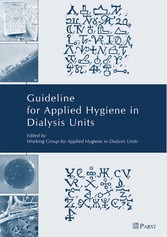Search and Find
Service
Table of Content
6
Preface to the 2nd Edition
12
Additional preface to the translated 2nd Edition 2008 in English
14
1 Introduction
16
16
17
1.1 Goals, Structure and Working Method of the Working Group
17
17
18
18
19
1.2 Purpose
19
1.3 Usage and Assessment
19
19
20
20
21
21
22
1.4 Quality and Hygiene
22
22
23
23
24
24
25
25
26
26
27
2 Legal Basis
27
2.1 Definition of Responsibilities
27
2.2 Responsible Organisation
28
2.3 Equality of Occupational Health and Patient Safety
28
2.4 Biological Agents Ordinance ( BioStoffV)
29
2.5 The Hygiene Plan
32
3 Structural Requirements
37
3.1 Goal and Rationale
37
3.2 Space Required
37
3.3 Room Set-up and Installations
41
3.4 Sanitary Facilities
41
3.5 Requirements on the Indoor Air
42
3.6 Sewage System
42
4 Medical and Technological Requirements in Haemodialysis
44
4.1 Goal and Rationale
44
4.2 Water Purification
44
4.3 Dialysis Machines
47
5 Staff requirements
52
5.1 Goal and Rationale
52
5.2 Staffing Structure
52
5.3 Initial and Annual Instruction
53
6 Requirements for the Organisation
56
6.1 Goal and Rationale
56
6.2 General Hygiene
56
6.3 Water and Solutions for Haemodialysis Procedures
79
6.4 Monitoring and Evaluation of Permeate and Dialysis Fluids
81
6.5 Disinfection Measures for the Fluid Pathway and the Dialysis Machines
86
7 Particular Aspects of Hygiene in Dialysis Treatment
92
7.1 Vascular access
92
7.2 Home Dialysis Treatment
103
7.3 Special Epidemiological Aspects
109
8 Catering
145
8.1 Goal and Rationale
145
8.2 Hygienic Requirements for the Supply of Food to Patients
145
8.3 Requirements on Staff
146
8.4 Requirements on Staff Hygiene
148
8.5 Hygienic Requirements regarding Structural and Organisational Conditions
149
8.6 Hygienic Requirements for Handling Foodstuffs
151
9 Waste Management
154
9.1 Goal and Rationale
154
9.2 Legal Basis and Recommendations for Waste Management
154
9.3 Type and Origin of Wastes
154
9.4 Classification of Waste Types
156
10 Examination of the Effectiveness of Disinfection Procedures for Dialysis Machines
160
11 Check Lists and Forms
161
11.1 Home Haemodialysis
161
11.2 Peritoneal Dialysis – Preconditions and Operation
163
11.3 Quality Requirements for Drinking Water and Permeate
165
11.4 Letter to Communal Water Suppliers
167
11.5 Return of Dialysis Machines from Patients with Blood- Transmissible Viral Infections
168
11.6 HBV Diagnostics
169
11.7 HCV Diagnostics
171
11.8 Post Exposure Prophylaxis ( PEP) for Staff
172
11.9 Indication for the Initiation of Pharma-cotherapy as Post Exposure Prophylaxis ( PEP) in Case of Exposure to HIV
173
11.10 HBV Post Exposure Prophylaxis ( PEP) for Staff after Presumable Contact with HBV- Containing Material
173
11.11 HCV Post Exposure Prophylaxis ( PEP) for Staff
174
11.12 Hygiene Measures during Infectious Illnesses
175
11.13 Information Sheet for MRSA Patients
178
11.14 MRSA Infection – Plan for procedure – EXAMPLE142
181
11.15 Template for Catering
183
12 Abbreviations
186
All prices incl. VAT













